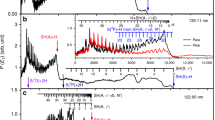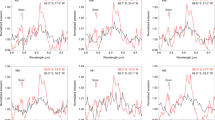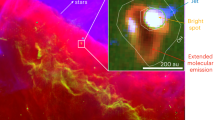Abstract
DURING the past year, radio astronomers1,2 have been increasingly interested in microwave signals at frequencies of 1,612, 1,665, 1,667 and 1,720 Mc/s, produced by transitions between four energy levels of the OH molecule in the 2Π3/2 state. Theoretical and laboratory intensity ratios3 for the four microwave lines were found to be 1 : 5 : 9 : 1. It was reported1 recently that anomalous intensity ratios had been measured in the strong OH absorption lines of the radio source Sagittarius A. McGee et al.4 have extended their measurements to other radio sources and find emission and absorption at all four frequencies with instances of extremely anomalous intensity ratios.
This is a preview of subscription content, access via your institution
Access options
Similar content being viewed by others
References
Gardner, F. F., Robinson, B. J., Bolton, J. G., and van Damme, K. J., Phys. Rev. Letters, 13, 3 (1964).
Robinson, B. J., Gardner, F. F., van Damme, K. J., and Bolton, J. G., Nature, 202, 989 (1964).
Radford, H. E., Phys. Rev. Letters, 13, 534 (1964).
McGee, R. X., Robinson, B. J., Gardner, F. F., and Bolton, J. G., Nature (preceding communication).
Herzberg, G., Molecular Spectra and Molecular Structure; Spectra of Diatomic Molecules (D. Van Nostrand Co., Inc., 1959).
Garvin, D., Broida, H. P., and Kostkowski, H. J., J. Chem. Phys., 32, 880 (1960).
King, I. R., J. Chem. Phys., 37, 74 (1962).
Miller, W. J., and Calcote, H. F., J. Chem. Phys., 41, 4001 (1964).
Weaver, H., Williams, D. R. W., Dieter, N. H., and Lum, W. T., Nature, 208, 29 (1965).
Weinreb, S., Meeks, M. L., Carter, J. C., Barrett, A. H., and Rogers, A. E. E., Nature, 208, 440 (1965).
Author information
Authors and Affiliations
Rights and permissions
About this article
Cite this article
SYMONDS, J. Formation of Hydroxyl Molecules in Interstellar Space. Nature 208, 1195–1196 (1965). https://doi.org/10.1038/2081195a0
Issue Date:
DOI: https://doi.org/10.1038/2081195a0
This article is cited by
-
Mechanism for Anomalous OH Emission from HII Regions
Nature (1967)
Comments
By submitting a comment you agree to abide by our Terms and Community Guidelines. If you find something abusive or that does not comply with our terms or guidelines please flag it as inappropriate.



